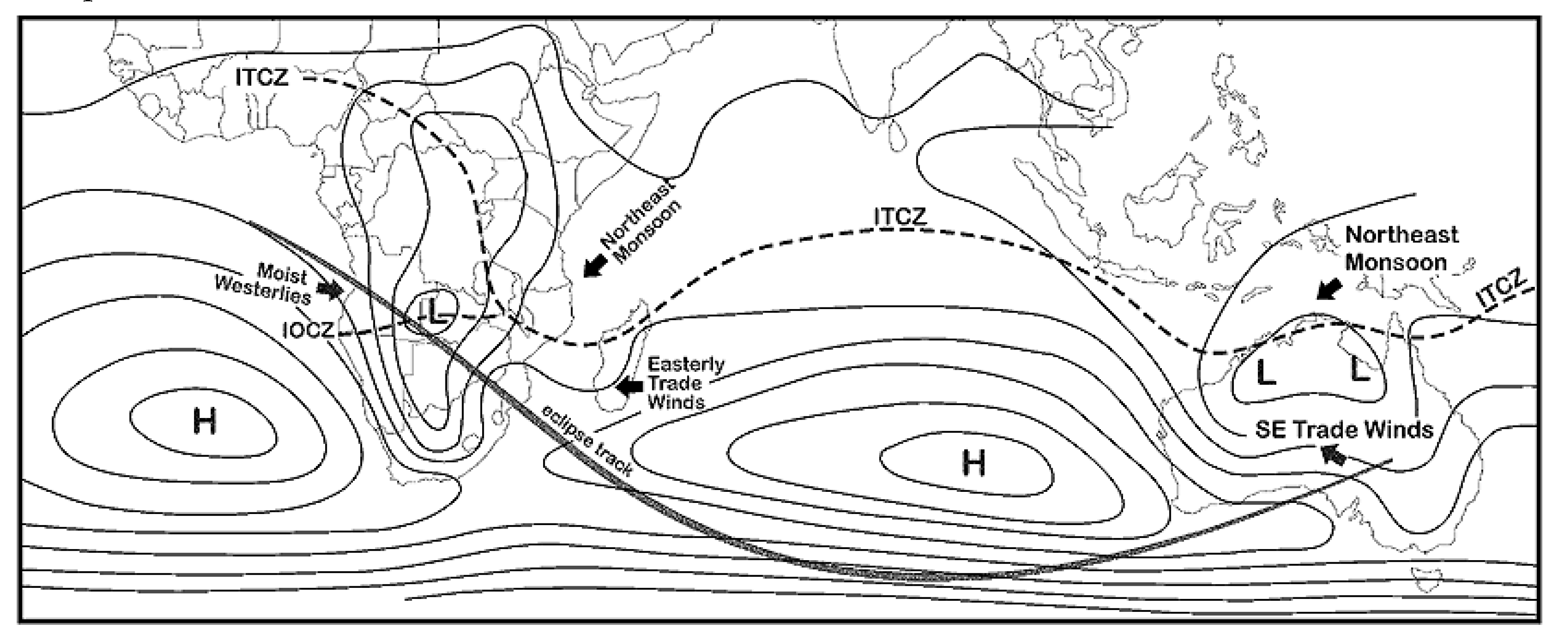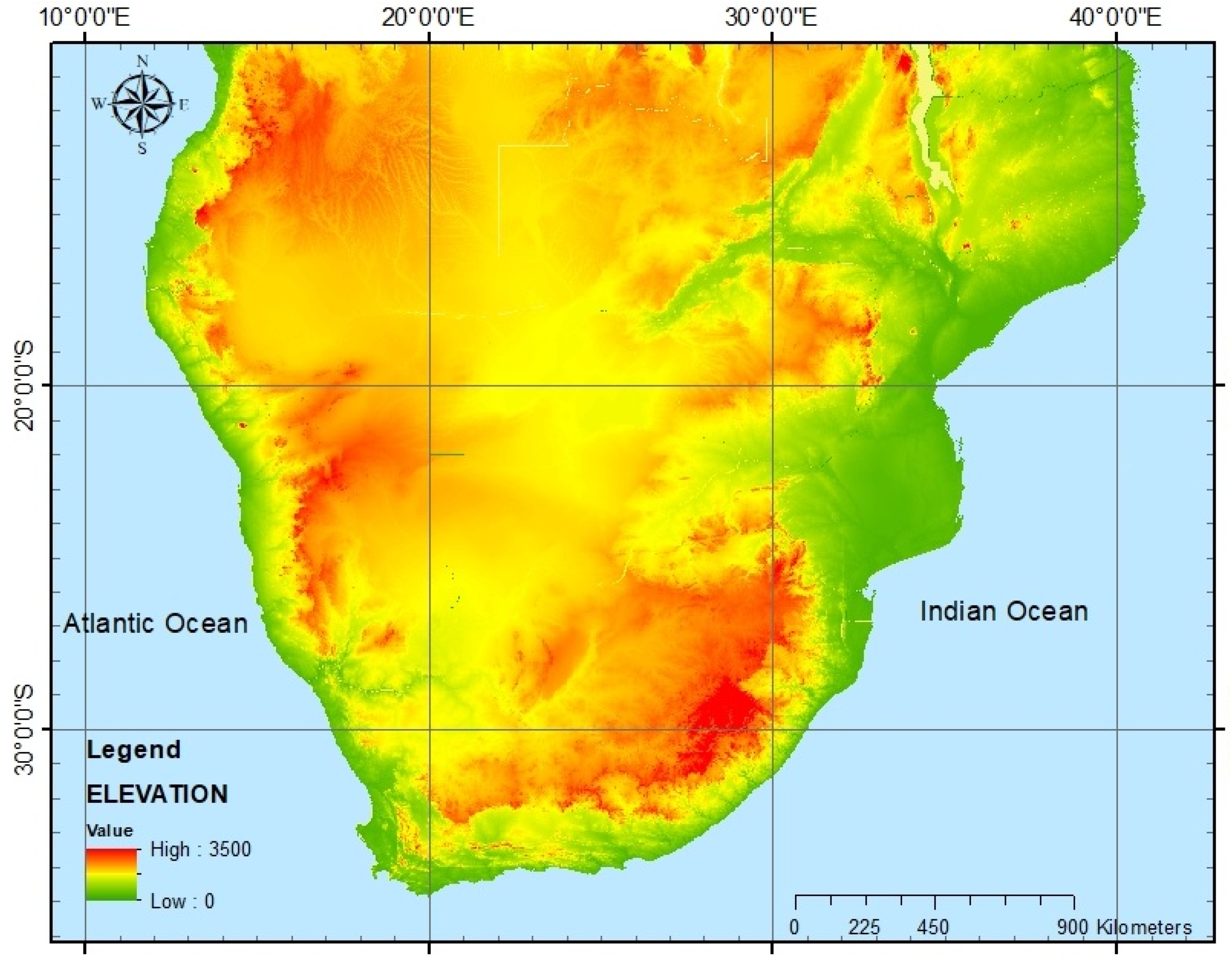Climatology of the Mascarene High and Its Influence on Weather and Climate over Southern Africa
Abstract
1. Introduction
2. General Circulation
3. Mascarene High Climatology and Temporal Variability
3.1. Mean Spatial and Seasonal Characteristics
3.2. Indian Ocean SSTs and Mascarene High Interannual Variability
3.3. Moisture Flux, Meridional Pressure Gradient, and the Angola Low

3.4. The Mid-Tropospheric Botswana High
4. Mascarene High and Extreme Events in Southern Africa
4.1. Mascarene High Blocking
4.2. Steering of Tropical Revolving Systems
4.3. Cut-Off Lows
5. Climate Change Impacts
6. Conclusions
Author Contributions
Funding
Acknowledgments
Conflicts of Interest
References
- Cherchi, A.; Ambrizzi, T.; Behera, S.; Freitas, A.; Morioka, Y.; Zhou, T. The response of subtropical highs to climate change. Curr. Clim. Chang. Rep. 2018, 4, 371–382. [Google Scholar] [CrossRef]
- Miyasaka, T.; Nakamura, H. Structure and mechanisms of the Southern Hemisphere summertime subtropical anticyclones. J. Clim. 2010, 23, 2115–2130. [Google Scholar] [CrossRef]
- Sinclair, M.R. A climatology of subtropical anticyclones and blocking for the Southern Hemisphere. Mon. Weather Rev. 1996, 124, 245–263. [Google Scholar] [CrossRef]
- Tyson, P.D.; Preston-Whyte, R.A. Weather and climate of southern Africa; Oxford University Press: Cape Town, South Africa, 2000; 396p. [Google Scholar]
- Reboita, M.S.; Ambrizzi, T.; Silva, B.; Pinheiro, R.; Da Rocha, R.P. The South Atlantic subtropical anticyclone: Present and future climate. Front. Earth Sci. 2019, 7, 1–15. [Google Scholar] [CrossRef]
- Seager, R.; Murtugudde, R.; Naik, N.; Clement, A.; Gordon, N.; Miller, J. Air-Sea Interaction and the seasonal cycle of the subtropical anticyclones. J. Clim. 2003, 16, 1948–1966. [Google Scholar] [CrossRef]
- Feba, F.; Ashok, K.; Ravichandran, M. Role of changed indo-pacific atmospheric circulation in the recent disconnect between the Indian summer monsoon and ENSO. Clim. Dyn. 2019, 52, 1461–1470. [Google Scholar] [CrossRef]
- Zhao, S.; Feng, T.; Tie, X.; Long, X.; Li, G.; Cao, J.; Zhou, W.; An, Z. Impact of Climate Change on Siberian High and Wintertime Air Pollution in China in Past Two Decades. Earths Future 2018, 6, 118–133. [Google Scholar] [CrossRef]
- Richter, I.; Mechoso, C.R. What determines the position and intensity of the South Atlantic Anticyclone in austral winter? —An AGCM study. J. Clim. 2008, 21, 214–229. [Google Scholar] [CrossRef]
- Xue, F.; Wang, H.J.; He, J.H. Interannual variability of Mascarene High and Australian High and their influence on the East Asian summer rainfall over East Asia. Chin. Sci. Bull. 2004, 48, 492–497. [Google Scholar] [CrossRef]
- Encyclopedia Britannica. Indian Ocean|History, Map, Depth, Islands, & Facts. Available online: https://www.britannica.com/place/Indian-Ocean (accessed on 4 March 2020).
- Manatsa, D.; Morioka, Y.; Behera, S.K.; Matarira, C.H.; Yamagata, T. Impact of Mascarene High variability on the East African ‘short rains’. Clim. Dyn. 2014, 42, 1259–1274. [Google Scholar] [CrossRef]
- Ohishi, S.; Sugimoto, S.; Hanawa, K. Zonal movement of the Mascarene High in austral summer. Clim. Dyn. 2015, 45, 1739–1745. [Google Scholar] [CrossRef]
- Keable, M.; Simmonds, I.; Keay, K. Distribution and temporal variability of 500 hPa cyclone characteristics in the Southern Hemisphere. Int. J. Climatol. 2002, 22, 131–150. [Google Scholar] [CrossRef]
- Collins, J.A.; Fauser, B.C.J.M. Balancing the strengths of systematic and narrative reviews. Hum. Reprod. Update 2005, 11, 103–104. [Google Scholar] [CrossRef] [PubMed]
- Wallace, J.M.; Hobbs, P.V. Atmospheric Science: An Introductory Survey; Academic Press: Amsterdam, The Netherlands, 2006. [Google Scholar]
- Mahlobo, D.D.; Ndarana, T.; Grab, S.; Engelbrecht, F. Integrated climatology and trends in the subtropical Hadley cell, sunshine duration and cloud cover over South Africa. Int. J. Climatol. 2018, 39, 1805–1821. [Google Scholar] [CrossRef]
- Li, L.; Li, W.; Kushnir, Y. Variation of the North Atlantic subtropical high western ridge and its implication to Southeastern US summer precipitation. Clim. Dyn. 2012, 39, 1401–1412. [Google Scholar] [CrossRef]
- Rodwell, M.J.; Hoskins, B.J. Subtropical anticyclones and summer monsoons. J. Clim. 2001, 14, 3192–3211. [Google Scholar] [CrossRef]
- Sreenivasan, B.; Davidson, P. On the formation of cyclones and anticyclones in a rotating fluid. AIP 2008, 20, 085104. [Google Scholar] [CrossRef]
- Cook, K.H. On the response of the Southern Hemisphere to ENSO. In Proceedings of the 23rd Climate Diagnostics and Prediction Workshop, Miami, FL, USA, 26–30 October 1998; pp. 323–326. [Google Scholar]
- Goddard, L.; Graham, N.E. Importance of the Indian Ocean for simulating rainfall anomalies over eastern and southern Africa. J. Geophys. Res. 1999, 104, 19099–19116. [Google Scholar] [CrossRef]
- Morioka, Y.; Tozuka, T.; Yamagata, T. How is the Indian Ocean subtropical dipole excited? Clim. Dyn. 2013, 41, 1955–1968. [Google Scholar] [CrossRef]
- Bjerknes, J. Atmospheric teleconnections from the equatorial pacfiic 1. Mon. Weather Rev. 1969, 97, 163. [Google Scholar] [CrossRef]
- Feng, X.; Dabang, J.; Xianmei, L.; Huijun, W. Influence of the Mascarene high and Australian high on the summer monsoon in East Asia: Ensemble simulation. Adv. Atmos. Sci. 2003, 20, 799–809. [Google Scholar] [CrossRef]
- Rao, B.S.; Rao, D.B.; Rao, V.B. Decreasing trend in the strength of Tropical Easterly Jet during the Asian summer monsoon season and the number of tropical cyclonic systems over Bay of Bengal. Geophys. Res. Lett. 2004, 31, L14103. [Google Scholar] [CrossRef]
- Ogwang, B.A.; Ongoma, V.; Xing, L.; Ogou, K.F. Influence of Mascarene high and Indian Ocean dipole on East African extreme weather events. Geograph. Pannonica 2015, 19, 64–72. [Google Scholar]
- Yamagata, T.; Behera, S.K.; Luo, J.-J.; Mason, S.; Jury, M.; Rao, S.A. Coupled ocean-atmosphere variability in the tropical Indian Ocean. In Earth Climate: The Ocean-Atmosphere Interaction; American Geophysical Union: Washington, DC, USA, 2004; Volume 147, pp. 189–212. [Google Scholar]
- Chikoore, H. Drought in Southern Africa: Structure, Characteristics. Ph.D. Thesis, University of Zululand, Empangeni, South Africa, 2016. [Google Scholar]
- Manatsa, D.; Behera, S.K. On the epochal strengthening in the relationship between rainfall of East Africa and IOD. J. Clim. 2013, 26, 5655–5673. [Google Scholar] [CrossRef]
- Manatsa, D.; Chingombe, W.; Matarira, C.H. The impact of the positive Indian Ocean dipole on Zimbabwe droughts. Int. J. Climatol. 2008, 28, 2011–2029. [Google Scholar] [CrossRef]
- Manatsa, D.; Matarira, C.H. Changing dependence of Zimbabwean rainfall variability on ENSO and the Indian Oceann dipole/zonal mode. Theor. Appl. Climatol. 2009, 98, 375–396. [Google Scholar] [CrossRef]
- Behera, S.K.; Yamagata, T. Subtropical SST dipole events in the southern Indian Ocean. Geo. Res. Lett. 2001, 28, 327–330. [Google Scholar] [CrossRef]
- Reason, C.J.C. Subtropical Indian Ocean SST dipole events and southern African rainfall. Geophys. Res. Lett. 2001, 28, 2225–2227. [Google Scholar] [CrossRef]
- Reason, C.J.C. Sensitivity of the southern African circulation to dipole sea-surface temperature patterns in the Indian Ocean. Int. J. Climatol. 2002, 22, 377–393. [Google Scholar] [CrossRef]
- Morioka, Y.; Takaya, K.; Behera, S.K.; Masumoto, Y. Local SST impacts on the summertime Mascarene high variability. J. Clim. 2015, 28, 678–694. [Google Scholar] [CrossRef]
- Nkurunziza, I.F.; Guirong, T.; Ngarukiyimana, J.P.; Sindikubwabo, C. Influence of the Mascarene High on October-December rainfall and their associated atmospheric circulation anomalies over Rwanda. J. Environ. Agric. Sci. 2019, 20, 1–20. [Google Scholar]
- Fauchereau, N.; Trzaska, S.; Richard, Y.; Roucou, P.; Camberlin, P. Sea-surface temperature co-variability in the southern Atlantic and Indian Oceans and its connections with the atmospheric circulation in the Southern Hemisphere. Int. J. Climatol. 2003, 23, 663–677. [Google Scholar] [CrossRef]
- Hermes, J.C.; Reason, C.J.C. Ocean model diagnostics of interannual coevolving SST variability in the South Indian and South Atlantic Oceans. J. Clim. 2001, 18, 2864–2882. [Google Scholar] [CrossRef]
- Mulenga, H.M. Southern African Anomalies, Summer Rainfall and the Angola Low. Ph.D. Thesis, University of Cape Town, Cape Town, South Africa, 1998; 231p. [Google Scholar]
- Harrison, M.S.J. A generalized classification of South African summer rain-bearing synoptic systems. J. Climatol. 1984, 4, 547–560. [Google Scholar] [CrossRef]
- Todd, M.; Washington, R. Circulation anomalies associated with tropical-temperate troughs in southern Africa and the southwest Indian Ocean. Clim. Dyn. 1999, 15, 937–951. [Google Scholar] [CrossRef]
- Todd, M.; Washington, R.; Palmer, P.I. Water vapour transport associated with tropical–temperate trough systems over southern Africa and the southwest Indian Ocean. Int. J. Climatol. 2004, 24, 555–568. [Google Scholar] [CrossRef]
- Ratna, S.B.; Behera, S.K.; Ratnam, J.V.; Takahashi, K.; Yamagata, T. An index for tropical temperate troughs over southern Africa. Clim. Dyn. 2013, 41, 421–441. [Google Scholar] [CrossRef]
- Harangozo, S.; Harrison, M. On the use of synoptic data indicating the presence of cloud bands over southern Africa. S. Afr. J. Sci. 1983, 79, 413. [Google Scholar]
- Smith, A. Studies of the effects of cold fronts during rainy season weather in Zimbabwe. Weather 1985, 40, 198–203. [Google Scholar] [CrossRef]
- Diab, R.D.; Preston-Whyte, R.A.; Washington, R. Distribution of rainfall by synoptic type over Natal, South Africa. Int. J. Climatol. 1991, 11, 877–888. [Google Scholar] [CrossRef]
- Hart, N.C.; Reason, C.J.; Fauchereau, N. Cloud bands over southern Africa: Seasonality, contribution to rainfall variability and modulation by the MJO. Clim. Dyn. 2012, 41, 1199–1212. [Google Scholar] [CrossRef]
- Total Solar Eclipse—Weather for Africa. 2020. Available online: https://eclipse.gsfc.nasa.gov/SEmono/TSE2002/TSE2002txt/T02weather01.html#patterns (accessed on 28 March 2020).
- Elliott, R.D.; Smith, T.B. A study of the effects of large blocking anticyclones on the general circulation in the Northern Hemisphere westerlies. J. Appl. Meteorol. 1949, 6, 67–85. [Google Scholar]
- Sanders, R.A. Blocking Anticyclones over the eastern north Atlantic Ocean and western Europe. Mon. Weather Rev. 1953, 11, 67–73. [Google Scholar] [CrossRef]
- Miyamoto, A.; Nakamura, H.; Miyasaka, T. Influence of the Subtropical High and Storm Track on Low-Cloud Fraction and Its Seasonality over the South Indian Ocean. J. Clim. 2018, 31, 4017–4039. [Google Scholar] [CrossRef]
- Chikoore, H.; Vermeulen, J.H.; Jury, M.R. Tropical Cyclones in the Mozambique Channel: January-March 2012. Nat. Hazards 2015, 77, 2081–2095. [Google Scholar] [CrossRef]
- Singleton, A.T.; Reason, C.J.C. A numerical model study of an intense cut-off low pressure system over South Africa. Mon. Weather Rev. 2007, 135, 1128–1150. [Google Scholar] [CrossRef]
- Favre, A.; Hewitson, B.; Lennard, C.; Cerezo-Mota, R.; Tadross, M. Cut-off lows in the South Africa region and their contribution to precipitation. Clim. Dyn. 2013, 41, 2331–2351. [Google Scholar] [CrossRef]
- Engelbrecht, F.A.; Landman, W.A.; Engelbrecht, C.J.; Landman, S.; Bopape, M.M.; Roux, B.; McGregor, J.L.; Thatcher, M. Multi-scale climate modelling over southern Africa using a variable-resolution global model. Water SA 2011, 37, 647–658. [Google Scholar] [CrossRef]
- Engelbrecht, F.A.; McGregor, J.L.; Engelbrecht, C.J. Dynamics of the Conformal-Cubic Atmospheric Model projected climate-change signal over southern Africa. Int. J. Climatol. 2009, 29, 1013–1033. [Google Scholar] [CrossRef]
- Quan, X.; Hoerling, M.P.; Diaz, H.F.; Xue, T. How fast are the tropics expanding? J. Clim. 2014, 27, 1999–2013. [Google Scholar] [CrossRef]
- Waugh, D.W.; Garfinkel, C.I.; Polvani, L.M. Drivers of the recent tropical expansion in the Southern Hemisphere: Changing SSTs or ozone depletion? J. Clim. 2015, 28, 6581–6586. [Google Scholar] [CrossRef]
- Grise, K.M.; Davis, S.M.; Staten, P.W. Regional and seasonal characteristics of the recent expansion of the tropics. J. Clim. 2018, 31, 6839–6856. [Google Scholar] [CrossRef]
- Hu, Y.; Zhou, C.; Liu, J. Observational evidence for poleward expansion of the Hadley circulation. Adv. Atmos. Sci. 2011, 28, 33–44. [Google Scholar] [CrossRef]
- Scheff, J.; Frierson, D. Twenty-first-century multimodel subtropical precipitation declines are mostly midlatitude shifts. J. Clim. 2012, 25, 4330–4347. [Google Scholar] [CrossRef]


© 2020 by the authors. Licensee MDPI, Basel, Switzerland. This article is an open access article distributed under the terms and conditions of the Creative Commons Attribution (CC BY) license (http://creativecommons.org/licenses/by/4.0/).
Share and Cite
Xulu, N.G.; Chikoore, H.; Bopape, M.-J.M.; Nethengwe, N.S. Climatology of the Mascarene High and Its Influence on Weather and Climate over Southern Africa. Climate 2020, 8, 86. https://doi.org/10.3390/cli8070086
Xulu NG, Chikoore H, Bopape M-JM, Nethengwe NS. Climatology of the Mascarene High and Its Influence on Weather and Climate over Southern Africa. Climate. 2020; 8(7):86. https://doi.org/10.3390/cli8070086
Chicago/Turabian StyleXulu, Nkosinathi G., Hector Chikoore, Mary-Jane M. Bopape, and Nthaduleni S. Nethengwe. 2020. "Climatology of the Mascarene High and Its Influence on Weather and Climate over Southern Africa" Climate 8, no. 7: 86. https://doi.org/10.3390/cli8070086
APA StyleXulu, N. G., Chikoore, H., Bopape, M.-J. M., & Nethengwe, N. S. (2020). Climatology of the Mascarene High and Its Influence on Weather and Climate over Southern Africa. Climate, 8(7), 86. https://doi.org/10.3390/cli8070086






